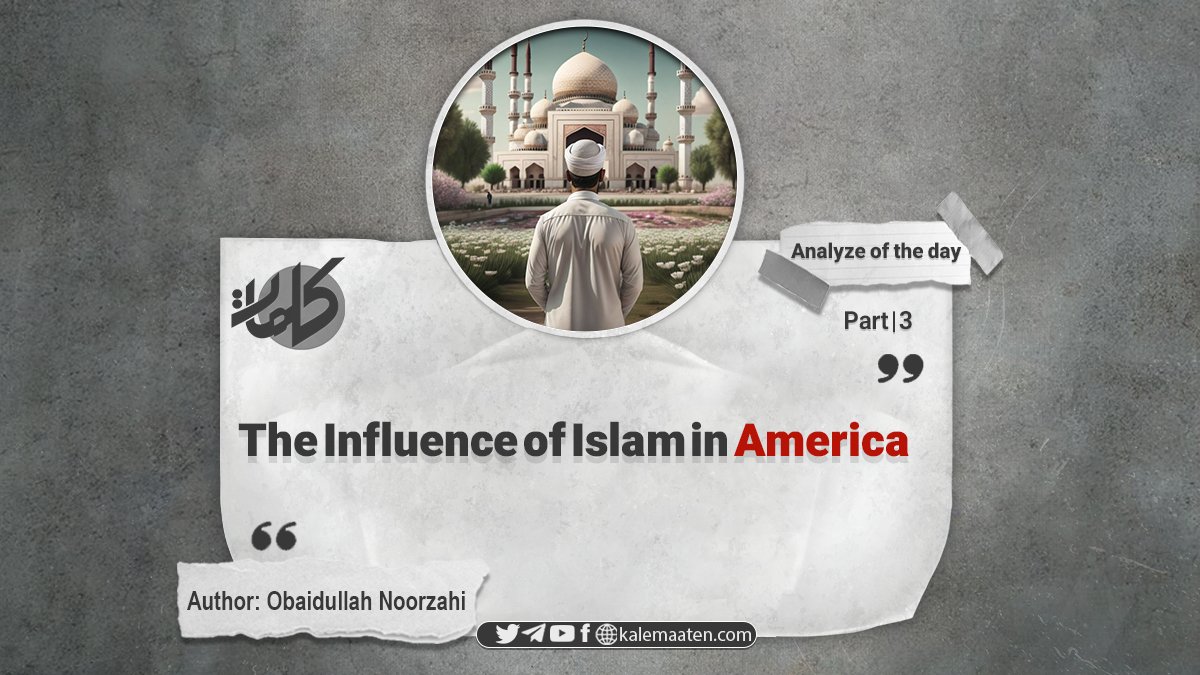Author: Obaidullah Noorzahi
The Influence of Islam in America (Part Three)
The United States of America
The Federal Republic of the United States of America, covering an area of 9,369,885 square kilometers, is located in the Western Hemisphere, in the northern part of the American continent and south of Canada.
This country has a population of 243 million, comprising white, Black, and indigenous people. Additionally, a mixture of these races can be observed in America. The official religion is Christianity, with Protestantism having the largest number of followers. The U.S. Constitution emphasizes the separation of religion from politics. The country’s capital is named Washington in honor of its first president. [1]
African Americans, who were subjected to four centuries of humiliation, insult, and subjugation by white Americans, form the most significant Muslim group in the country. The Islamic movement among African Americans began in 1913, and in the same year, the Nation of Islam, which Americans referred to as “Black Muslims,” announced its formation. Economic instability, unemployment, and severe racial discrimination, particularly from 1900 to 1930, forced over two million African Americans to migrate from the southern to the northern parts of the country. As a result, the population of Detroit increased by 600% during this period. This forced migration, accompanied by violence, significantly fueled African Americans’ resentment toward white people and their religion, leading many to turn to Islam. As C. Eric Lincoln, a professor and researcher at Boston University, states:
“Today, African Americans across the United States and Africa are turning away from Christianity and embracing Islam because they have found their voice in it. This is why white Americans shed more tears for Martin Luther King Jr. (the slain African American leader who spoke of the sanctity of Christianity), while African Americans’ anger grew after his death. They believed King had wasted their powerful energy in vain.” [2]
The growth of Islam among African Americans became more pronounced from 1930 onward. Due to Islamic preaching, the presence of suitable conditions, the ease of adopting the religion, and Islam’s strong stance against racism, it spread among African Americans. When a Muslim named Fard Muhammad (Farad Muhammad) migrated to the U.S. and settled in Detroit, Black Muslims gained significant organization. However, after his sudden disappearance, the leadership of the Black Muslim movement was taken over by Elijah Muhammad, who led and organized them until his death in 1975. Before him, a Muslim named Wallace Fard also played a key role in the formation of the Black Muslim community.
Elijah Muhammad led the Black Muslim organization for 44 years, successfully increasing its membership severalfold and establishing numerous mosques across the country. He also maintained strong relations with Islamic countries in Africa and the Middle East. In 1934, a year after he assumed leadership, the organization’s membership was around 8,000, but by 1970, it had grown to 250,000. Mosques played a crucial role in uniting Black Muslims, and the organization was characterized by strong military discipline. The first Muslim school in the country was established in 1932 as an Islamic university in Detroit, followed by another in Chicago in 1934.
The political goal of Black Muslims was to establish their own homeland in America by utilizing the liberating teachings of Islam and separating themselves from white Americans in terms of land ownership. In general, they aimed to form a united front of African Americans. However, Black Muslims lived in a society where they had little political or administrative influence and were subjected to severe political pressure from the police.
The Ku Klux Klan (K.K.K.), a secret racist organization, committed horrific acts against African Americans. This group prevented Muslim gatherings and engaged in brutal acts such as amputations and branding the bodies of Black Muslims with heated iron. Malcolm X, [3] a prominent Black Muslim leader, was assassinated on February 21, 1965, by members of this organization. The CIA initially attempted to blame the Nation of Islam for his murder, but later investigations revealed that the agency itself was behind the assassination. [4]
In 1992, protests by African Americans escalated into violent riots across the United States. These widespread demonstrations erupted after a Los Angeles court acquitted four out of five police officers accused of severely beating an African American motorcyclist named Rodney King. The riots first broke out in Los Angeles and then spread to other states. In addition to African Americans, many dissatisfied white Americans also joined the protests. These uprisings played a significant role in exposing America’s hypocrisy regarding human rights and its false reputation as a land of peace and prosperity.
In 1855, a Syrian Muslim named Haj Ali traveled to the U.S. to introduce camel breeding in the Arizona desert. Following his arrival, a group of Syrians also migrated to America. After World War I, several Muslims from Eastern Europe, particularly from former Yugoslavia, Albania, and Poland, moved to the U.S. to escape Marxist persecution. However, after World War II, waves of migration from various Muslim-majority regions, particularly the Middle East, the Indian subcontinent, and Malaysia, increased. Throughout these migrations, significant groups in America embraced Islam.
Professor Rainer Haruo, a professor of theology at Dartmouth College, stated: “The Nation of Islam emerged in America in 1932. Since the 1950s, most Muslims coming to the U.S. have been highly educated professionals.” [5]
Continues…
[1] America’s Little Mainstream by Harvey Arden. National Geographic Mrs 1977 pa:355.
[2] Michael Bergen, translated by Farshid Mazinani, Introduction to the Life of Muhammad Ali Kali, p. 655, Tehran – Moj Publications.
[3] Malcolm X, the leader of the American Black movement, was born on May 19, 1925, into a poor Muslim family in the state of Benares, USA. When he was 4 years old, his house was burned down by racist sects. In 1952, he joined the underground Black movement and succeeded in building mosques for Muslims in Detroit and Philadelphia. In the spring of 1964, he separated from the Alijah Muhammad movement with the aim of forming the African-American Black Unity Organization.
[4] Alexei Hill, translated by Gholamhossein Keshavarz, Malcolm X, Tehran, Amir Kabir, 1983.
[5] Michael Bergen, translated by Farshid Mazinani, The Life of Mohammad Ali Kali, p. 743, Tehran – Moj Publications.



